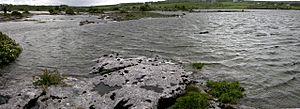Carmel National Nature Reserve facts for kids
Carmel National Nature Reserve is a special place near the village of Carmel in Carmarthenshire, Wales. It's located south of Llandeilo, not far from the main road to Llanelli. This reserve is a great spot for visitors, with a small car park, a picnic area, and footpaths to explore. You'll find a helpful notice board at the car park that tells you more about the area. The Wildlife Trust of South and West Wales and Natural Resources Wales (NRW) work together to look after this amazing reserve.
What is a Turlough?
Carmel National Nature Reserve has a very interesting geology, mostly made of Carboniferous Limestone. This is where you can find a unique feature called a turlough (lake), which is a lake that disappears! Turloughs are more common in Ireland, but the one here is the only known example in Britain.
The lake at Carmel, called Pant-y-Llyn turlough, fills up during autumn and winter. It gets its water only from groundwater, which is water stored underground. By summer, the lake completely dries up and disappears! This is exactly how a turlough behaves.
This special lake sits in a small dip in the ground. This dip was formed during the Ice Age along a crack in the Earth called the Betws Fault. Here, the Carboniferous Limestone meets older, waterproof rock. The way the water moves in and out of the lake is connected to how groundwater behaves in the limestone. The basin can fill up to about 3 meters deep. There are no rivers or streams flowing into or out of it on the surface. Instead, there's a swallow hole (a hole in the ground where water disappears) at one end of the basin.
All turloughs are found in areas with limestone. This is because limestone can be dissolved by rainwater. Rainwater becomes slightly acidic when it picks up carbon dioxide from the air. This acidic water then widens cracks and joints in the limestone. Eventually, all the rain falling on the limestone goes underground. The water moves through these openings, which can be tiny cracks or even large cave passages. When limestone has many of these features, it's called a karst landscape.
Amazing Plants
Over 100 different kinds of native woodland plants have been found at Carmel Reserve. There are also many types of mosses and other non-flowering plants. Some parts of the woodland have been here since the Middle Ages!
To help wildflowers grow, some areas of the woodland are coppiced. This means trees are cut back to ground level, which encourages new shoots and lets more light reach the forest floor. Other parts of the woodland are left mostly untouched, with very little human interference.
You can find some rare plant species here, such as mezereon (Daphne mezereum), toothwort (Lathraea squamaria), lily-of-the-valley (Convallaria majalis), and herb paris (Paris quadrifolia).
Wildlife at the Reserve
The turlough lake is a breeding ground for frogs, toads, and newts. Nearby caves provide homes for bats, including the rare greater horseshoe bat (Rhinolophus ferrumequinium). In the coppiced woodland, you might spot dormouses. The reserve is also home to several types of butterfly and a wide variety of other insects.
The different types of soil at Carmel create a mix of unique habitats right next to each other. These include ash woods, grasslands rich in different plant species, heathland, and open water. In spring, beautiful flowers like the primrose (Primula vulgaris) and the lesser celandine bloom.
The area around the reserve is a mix of traditional farms and quarrying. You'll also see ancient woodlands and old field systems. Forestry (growing trees for wood) is also common in the landscape.
Images for kids



